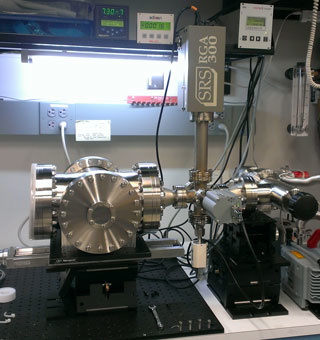Get a good look; it won’t be on earth for long.
At least that’s the hope of Hannah Marlowe, a third-year doctoral student in the Department of Physics and Astronomy, who recently received one of nine NASA Earth and Space Science Fellowships in astrophysics to further her work on the device, a gamma-ray burst polarimeter.
NASA awards these prestigious fellowships to “ensure continued training of a highly qualified workforce in disciplines needed to achieve NASA’s scientific goals,” one of which is to determine how matter, space, and time evolve under extreme conditions in the universe.

Marlowe, originally from Dacula, Ga., is developing the instrument to study the radiation produced by giant explosions in far away galaxies called gamma-ray bursts. These bursts, which emit extremely powerful light in the form of X-rays and gamma rays, are the most energetic explosions in the known universe and are thought to occur when massive stars collapse into black holes or when two compact objects collide. However, despite extensive research, many facts surrounding the bursts remain a mystery to scientists.
“We still don’t know exactly what’s going on to produce the light that we observe,” says Marlowe.
But by studying properties of the X-rays the gamma-ray bursts emit, she and her colleagues hope to figure out the fundamental emission processes present in the explosion.

Enter the gamma-ray burst polarimeter, which looks surprisingly like a silver fire hydrant lying on its side with its top sliced off. Inside, on tiny stilts, sits a delicate structure assembled from high-voltage plates, electric field forming rings, and thin polymer and copper sheets called Gas Electron Multipliers. The device is designed to measure certain properties of X-rays, such as their polarization, or orientation. As X-rays enter the detector, they interact with carbon dioxide gas, which causes an electron to pop out of a gas molecule in a direction related to the X-ray’s polarization.
Marlowe is working with NASA scientists to fine-tune the polarimeter, with the aim of one day installing it on a satellite and launching it into orbit to collect data on actual gamma-ray bursts, to determine how light was generated in the explosions. (She and her colleagues currently use lab-generated X-rays for these tests.) This means occasionally disassembling her entire lab and transporting it—via minivan, if necessary—to NASA’s Goddard Space Flight Center in Maryland.
It’s a daunting task, but it’s one Marlowe enjoys. “I like going into a lab, tinkering with things, machining things in the shop, putting them together and taking them apart,” she says. In fact, one of her fondest childhood memories is building a motion detector with her father, soldering the parts together and learning how it worked.
She traces her interest in physics and astronomy to her first physics class in high school, taught by a retired NASA engineer, who started an astronomy club at the school. “Right away,” she says, “I liked the idea of looking out at the universe and trying to figure out what’s going on.”
Marlowe went on to major in astrophysics at Agnes Scott College, a women’s college in Decatur, Ga. “I didn’t really set out to go to a women’s college,” she says, “but I fell in love with the school when I found it, and it was a really unique experience that all of my peers in STEM classes were also women.”
Marlowe credits her UI faculty advisor, professor Phil Kaaret, for her success. Not only did he involve her in his group’s NASA research from the moment she arrived on campus, but he also suggested that she apply for the fellowship.
“He’s been a tremendous influence and has opened many doors for me,” she says.